
by Jean Marie Carey | 19 Sep 2016 | Animals in Art, Art History, Franz Marc

SINTRAX Kaffeebereiter, 1932, Gerhard Marcks.
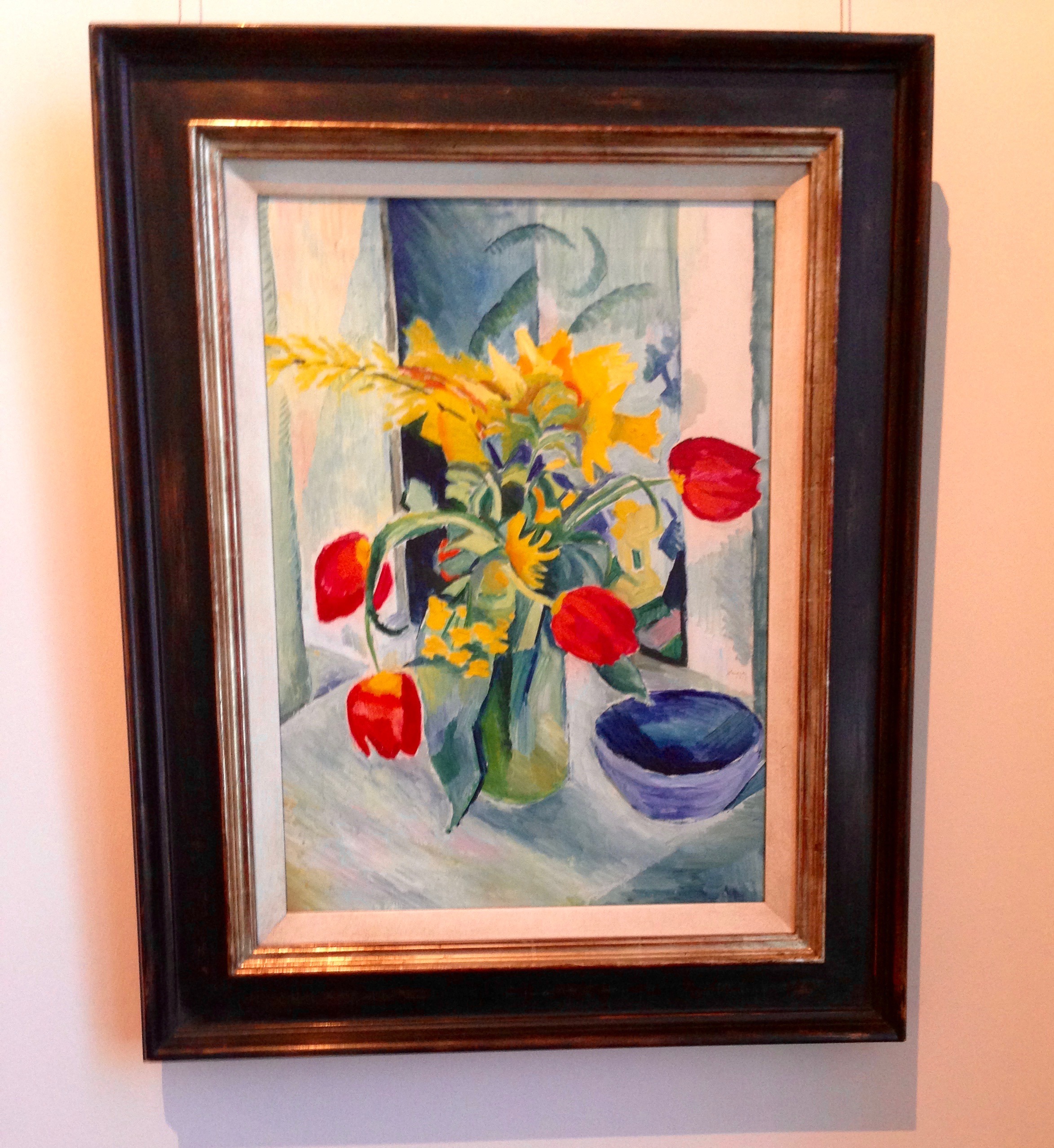
August Macke, Stillleben mit Tulpen, 1912
First I would encourage you to just skip this text and go right to the photos!
Otherwise: I went to Animalia: Interdisciplinary Perspectives and Explorations at the beginning of September mostly to see what the undergraduates and MA candidates were working on. The animal studies program at Carl von Ossietzky Universität Oldenburg is based within the Institute for American / English Studies. Though there was a mix of literary and cultural Human Animal Studies at hand the distinctive approach of this program is to examine the discipline through gender studies.
A highlight of the trip (in fact I devoted a whole day and night and went back the next day for this little side excursion) was visiting the Landesmuseum für Kunst und Kulturgeschichte Oldenburg which is actually three buildings: Oldenburger Schloss, Augusteum, and Prinzenpalais; devoted to regional history, international “Old Masters,” and modern art, respectively.
The museums were fantastic in showcasing some artists you hear less about, or in prominent placement of less-famous works by people who are very well-known. The outstanding discoveries for me were a mournful 1937 still life by Gabriele Münter called Puppe, Katz, Kind; a the cheerful small Stillleben mit Tulpen by August Macke (which I think might be unfinished; it is very uncharacteristic in its facture of his work at this time) from 1912; Wilhelm Lehmbruck’s early Grace (1905); the subdued placement of Kurt Lehmann’s Sinnender Knabe (1948), who had a lot to think about, and a delightful whirligig coffee making device from Gerhard Marcks’s highest Bauhaus phase in 1932.
-

-
Wilhelm Lehmbruck, “Grace,” 1905.
-

-
Gabriele Münter, “Puppe, Katz, Kind,” 1937
-

-
Kurt Lehmann, “Sinnender Knabe,” 1948.
The Prinzenpalais is the collection that recently had its Max Liebermann Reiter am Strand (1909) returned to it, one of the most expeditiously executed rectitudes of the 2013 Cornelius Gurlitt recovery in München. The Prinzenpalais’s reaction to this turn of events seems strangely half-hearted, with just a small vitrine of the correspondence relating to Hildebrand Gurlitt’s involvement in the brokering the resale of the then-Entartete Kunst Reiter, and no explanation of the situational context really anywhere. I asked the docents if they were happy about having the painting back; they clearly weren’t all that happy, and doubly not to have someone ask informed questions.
Oldenburg has a nice Altstadt near the Landesmuseum but as middle-sized German cities go is somewhat difficult to get around in as it has only bus service, no UBahn or even a Straßenbahn or light rail system. Right now there is a lot of road construction with many ersatz Haltestellen and barricaded sidewalks, which the Münster- and Hamburg-aggression level Radler do not seem to be taking into consideration. Excluding Berlin, the farther north I go, the less I like it, and the more I recognize what a confirmed Südländerin I am.
-

-
Der H. Georg im Kampf mit der Drachen, c. 1512, Meister de Georgeschreins von Zwischenahn Eiche.
-
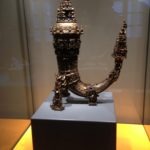
-
Das Wunderhorn, 1655, Fränkisch.
-
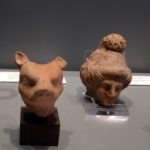
-
Hundekopf, Kopf des Zeus, c. 200 BCE, Tarent, Italien.
-

-
Franz Radziwill, Mosaik, 1948.
-

-
Scale mit Kauerndem Frauenakt, 1925, Rena Buthaud.
-

-
Bauhaus Schachspiel, “Model XVI,” 1924. Josef Hartwig.
-

-
Bauhaus Schachspiel, “Model XVI,” 1924. Josef Hartwig.
-
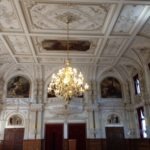
-

-
Franz Radziwill, Mosaik, 1948, Detail.
-
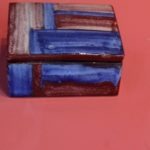
-
Zigarettendose, Gertrud Kraut, 1928.
-

-
Kinderschlitten um 1730.
-

-
Werbeplakat für Jugend, 1897.
-

-
Willem Claesz, Frühstücksstilleben, 1645.
-
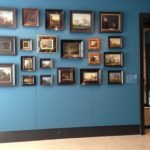
-
Clutter.
-

-
Raum für Max Liebermanns Ölgemälde “Reiter am Strand” von 1909.
-

-

-

-

-

-
Max Lieberman / Kunst und Künstler.
-

-
Max Liebermanns Ölgemälde “Reiter am Strand” von 1909.
-
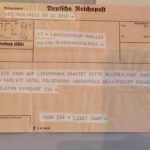
-
Dokumentation von Familie Gurlitt von Max Liebermanns Ölgemälde “Reiter am Strand” von 1909.
-

-
Dokumentation von Familie Gurlitt von Max Liebermanns Ölgemälde “Reiter am Strand” von 1909.
-
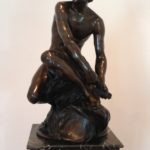
-
Jean Baptiste Pigalle, Merkur, 1785.
-

-
Detail of building.
-

-
Reneé Sintenis, August Gaul, Ewald Mataré, Richard Scheibe
-
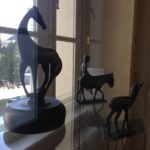
-
Reneé Sintenis, August Gaul, Ewald Mataré, Richard Scheibe
-

-
Reneé Sintenis, August Gaul, Ewald Mataré, Richard Scheibe
-

-
Hans Hermann Weyl, Anneliese von Arnim als Kind, 1905.
-
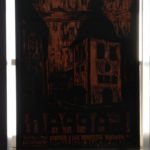
-
Erich Heckel’s plate from Die Brücke catalogue…

by Jean Marie Carey | 16 Mar 2016 | Animals in Art, Art History, August Macke, Dogs!, Expressionismus, Franz Marc, German Expressionism / Modernism
 Indexical photo with authorial shadow; graves of Franz and Maria Marc
Indexical photo with authorial shadow; graves of Franz and Maria Marc
On 4 March 2016, the 100th anniversary of the death of the painter, animal lover, writer, and ever-elusive person Franz Marc, I visited Marc’s grave in Kochel. Initially I had intended to spend the day between the Lenbachhaus and the Pinakothek der Moderne in München immersed in the paintings I have studied now for many years. But in truth I am devoted to Marc’s life as much as his art, and it seemed more right to take make a pilgrimage and pay respects in the proper sense of the word in the tiny Bavarian town where Marc lived off and on.
This trip was covered on the now-silent Franz Marc Twitter account and received much support and nice wishes from many kind souls.
It was a very emotional experience and had some typical Bavarian humorous adventures as well. I arrived on the regional train at about 11:00 on a dazzling clear, cold day, with most of the snow from the previous week’s blizzard still on the ground. The Ammergau Alps, what Marc called „das blaues Land“, glowed. Inserting itself into this majestic, somber first act was the fact that, in Kochel, Ruhezeit on Fridays apparently begins at 11:00…and this was a very intense Ruhezeit too…everything had abruptly closed, including the flower shop where I had intended to get some violets. I should add that all the flowers and plants were just sitting there outside, and the doors to the shop were open, but the lights were off and the people away being quiet. This was the same at other shops – I have always found it very amusing that in places where Ruhezeit is taken seriously, lunch places also close, even though Ruhezeit is at lunch time, and Kochel takes Ruhezeit quite seriously. In fact it was Friday Ruhezeit the entire time I was there. I stayed until 16:00, the hour of Marc’s death.
(more…)

by Jean Marie Carey | 3 Mar 2016 | Animals, Animals in Art, Art History, Expressionismus, Franz Marc, German Expressionism / Modernism

Franz Marc’s palette, from the archives of the Franz Marc Museum, Kochel.
Franz Marc’s “Aphorism 82,” from Die 100 Aphorismen, 1915.
“Ich sah das Bild, das in den Augen des Teichhuhns sich bricht, wenn es untertaucht: die tausend Ringe, die jedes kleine Leben einfassen, das Blau der flüsternden Himmel, das der See trinkt, das verzückte Auftauchen an einem andern Ort, – erkennt, meine Freunde, was Bilder sind: das Auftauchen an einem anderen Ort.”
“I saw what the moorhen sees as it dives: the thousand rings that encircle each little life, the blue of the whispering sky swallowed by the lake, the enraptured moment of surfacing in another place. Know, my friends, what images are: the experience of surfacing in another place.”

by Jean Marie Carey | 18 Feb 2016 | Animals, Animals in Art, Dogs!, Franz Marc, German Expressionism / Modernism, LÖL
 During February and March I am a Wissenschaftliche Gäste of sorts at the Universität Kassel’s Tier-Mensch Gesellschaft. I’m doing some research in the dOCUMENTA Archiv, finishing up a chapter in my dissertation, and giving a talk at this first-of-its-kind conference, “Animal Biographies: Recovering Animal Selfhood through Interdisciplinary Narration?”.
During February and March I am a Wissenschaftliche Gäste of sorts at the Universität Kassel’s Tier-Mensch Gesellschaft. I’m doing some research in the dOCUMENTA Archiv, finishing up a chapter in my dissertation, and giving a talk at this first-of-its-kind conference, “Animal Biographies: Recovering Animal Selfhood through Interdisciplinary Narration?”.
The program is incredible and the speakers amazing, each talk as fascinating as the next. There are also several installations and exhibits by Mathias Antlfinger and Ute Hörner and the interspecies collective from CMUK Köln. The program is free and you can register through 25 February through the link above.
I don’t know if I can quite live up to the talents of the other panelists, but I am confident of the attraction, pathos, and intrigue of my animal biographic subject, Russi Marc, whose death exactly 100 years ago this week was noted by his lifelong human companion, Franz Marc, who made many drawings and paintings of Russi through their lives together. Franz Marc himself died just a few weeks later. Studying Russi has taken on a life of its own in my research, and as this was a very well-documented dog and one who had many humorous and thrilling adventures I am very excited to be able to share his story with other animal lovers.
One thing I like so much about animal studies (in discussing the title of our nascent discipline, which is now beginning something like its second wave most of us are happy to jettison the “human-” prefix) is that its adherents are for the most part partisan activists. This challenge to the academy as we fight the losing battle of the Anthropocene and the Sixth Mass Extinction has not gone unnoticed; this week, a sort of prank article was exposed (and one could extrapolate perhaps planted by the same people or person), in the December 2015 issue of the academic journal Totalitarismus und Demokratie. In retrospect, perhaps a “discovery” about the inherited aggression of “German” German Shepherds was too good to be true…but I am very curious to see what the fallout will be, since the “research” depended upon “primary sources” about dogs…another reason to be glad for Russi’s well-established canine celebritude, I guess.

by Jean Marie Carey | 12 Feb 2016 | Animals, Animals in Art, Art History, Franz Marc

Franz Marc, Zwei Katzen, blau und gelb, 1912
The College Art Association conference was held 3-6 February in Washington, D.C., which for what I study is not a very interesting art city in the way New York City is…and D.C. is thus also very expensive to visit, since the trip doesn’t include a few precious hours in the Met, MoMA, Guggenheim, Neue Galerie, and so on.
If conferencing, not museum-visiting, is to be CAA’s focus going forward, the organization should do what the German Studies Association does, and move the meeting to some less-costly destinations that still have good mass transit and more of a range of hotel rooms, like Las Vegas or Atlanta.
This conference I had a lot of tasks I actually had to do, and one I wanted to do, or I should say was very curious about doing, attending the Historians of German, Scandinavian and Central European Art, or HGSCEA, [formerly just HGCEA, but, I guess the Munch people or something…] meeting, which this year took the form of a dinner honoring the long-reigning and undisputed chief Kandinsky scholar, Rose Carol Washton Long of the Graduate Center of the City University of New York, and Charles Haxthausen from Williams College.
I took the cryptic “honoring” on the invitation to mean “retiring,” which put me in mind of The King of the Cats. Miss Jessel’s “Haunted Palace” blog gives a nice account of the oral history tradition of this tale and its place in the folklore of the British Isles but, basically, without belaboring the point the outstanding extra-narrative moral for cat lovers and observers is probably that upon learning of the death of “the king of the cats,” all cats think that they are the designated heir to the throne.
So with respect to the fractious group of people who comprise known Kandinsky scholars…without an obvious heir apparent (to my mind there is not one, the once-promising regent having chosen their battles poorly), wouldn’t they all be prepared for anointment? As it turned out RCWL, in her very congenial speech, immediately made clear that while she was retiring from CUNY, she would not be relinquishing the reins to the Kandinsky dynasty anytime soon.
 The “party” itself was quite a mysterious affair in that it did not appear as an “affiliated society” event anywhere on the CAA schedule (or the new Linked-In developer-sponsored) app, and was held in a small restaurant in Adams Morgan which was entirely closed except for the HSGCEA dinner. RSVP, affiliation, and credentials were thoroughly vetted at the door, and there were no nametags. Nametags would not have been much use anyway, since everyone went by a non-apparent nickname, like “Ricki” or “Mark.” And it was very dark inside the restaurant, Lillie’s (actual lighting shown), and you couldn’t see even across the room. So in other words it was pretty much how I expected it to be, except there wasn’t any kind of St. Bartholomew’s day type of fracas, duel, or mass feline exit through the fireplace.
The “party” itself was quite a mysterious affair in that it did not appear as an “affiliated society” event anywhere on the CAA schedule (or the new Linked-In developer-sponsored) app, and was held in a small restaurant in Adams Morgan which was entirely closed except for the HSGCEA dinner. RSVP, affiliation, and credentials were thoroughly vetted at the door, and there were no nametags. Nametags would not have been much use anyway, since everyone went by a non-apparent nickname, like “Ricki” or “Mark.” And it was very dark inside the restaurant, Lillie’s (actual lighting shown), and you couldn’t see even across the room. So in other words it was pretty much how I expected it to be, except there wasn’t any kind of St. Bartholomew’s day type of fracas, duel, or mass feline exit through the fireplace.
As to my own paper and panel, I was thrown off my presentating game a little – not a lot, or not as much as I had expected or was undoubtedly intended – and got a lot of good questions, including some very specific queries from some more-than-casual idolators about Animalisierung, of all things, about the painting Tierschicksale, and about what I had specifically set out to talk about, affect/effect disturbing/calming animal images have upon human animal/human-animal empathy.
Basically my claim is that disapprobation toward animal abusers – such as generated by the film The Cove and the work of Sue Coe – is not as strong a motivator as true identification with the animal subject. Hence the focus on Franz Marc. This isn’t necessarily as obvious an idea as it seems, and bears more discussion and exploration (which is why I am writing about it).








































